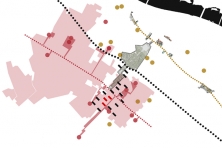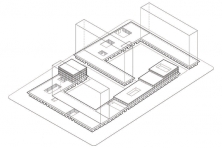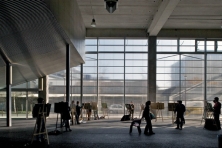On the Edge
Warszawa (PL) – Winner
TEAM DATA
Team Representative: Adrià Guardiet (ES) – architect urbanist
Contributor: Albert Estruga (ES) – architect
Provença 23, 1-2, 08029 Barcelona – España
+34 609 167 770 – adriaguardiet@gmail.com – www.adriaguardiet.cat
See the complete listing of portraits here
See the site page here

A. Guardiet and A. Estruga
INTERVIEW
1. How did you form the team for the competition?
I (Adrià Guardiet) met Albert at university and thought of him as a punctual contributor for this contest. We had never worked together before but the collaboartion was good so maybe we will work together again in the future...
2. How do you define the main issue of your project, insisting on how you answered on this session main topic: adaptability and urban rhythms?
The decisions regarding the project were based on the recognition of a series of problems and opportunities identified through the observation and critical interpretation of the place. The definition of a newly built perimeter that rearranges the open space and contains some uses aiming at giving life to the environment would not have been possible without a constant dialogue between the building and city scales.
The main topic of this edition of Europan –the capacity of transforming and adapting the project within time– was taken into account when defining the uses and the space management. We worked with a certain degree of indecisiveness in order, precisely, to highlight this mutable condition of the program.


3. How did this issue and the questions raised by the site mutation meet?
The proposal originates in the recognition of a series of characteristics that are specific to the location. It is more contextual than generic. We were interested in a transformation that was conceptually radical but respectful to the memory and identity of the location.
Therefore, the main theme of this edition of Europan was not a starting point in our case, but rather an aspect that conditioned the development of the proposal. For example, we used structures with large spans for the new buildings. This type of structure gives the building a high degree of versatility and capacity for transformation by allowing all sorts of internal configurations that are more or less provisional. This is a point in which we are greatly interested and which has a lot in common with the main theme of the competition.
4. Have you already treated this issue previously and could you present some reference projects that inspired yours?
The past competitions and projects on which I worked include some of these topics to a more or less explicit degree: versatility, multiple-use spaces, sustainability, processes based on participation, etc. These are different aspects of one same specific attitude. Any project by Lacaton & Vassal corresponds to this approach. Each of its projects is a lesson in what I am attempting to explain. For example, the Architecture School at Nantes: a big structure that is able to contain all sorts of situations.
Of course the influence of the Barcelona architectural culture in our project is also remarkable. Two examples of this sensitivity towards the city (neither in Barcelona!) are the Rome Map by Nolli and The Economist Group in London.

5. Today –within the era of an economic crisis and sustainability– the urban-architectural project should reconsider its production method in time; how did you integrate this issue in your project?
The key is to do more for less. I believe it is necessary to object to the formal and iconic excesses of the past few years. We must commit ourselves toward a low-tech, low-cost and high performance architecture that turns the user into the main focus as well as it interacts in a positive way with the town. We have to demand a quality public space, investment in facilities and new mobility policies.
6. Is it the first time you have been awarded a prize at Europan? How could this help you in your professional career?
Yes, this is the first time that I have participated. I do not know exactly how can it help me in my career... It would be fantastic to go ahead with the project! In any case, what I find really important in this competition is the accumulation of cultural energy. It's definitely a great opportunity for knowledge and discussion.